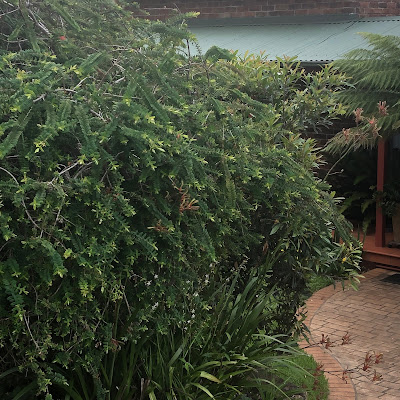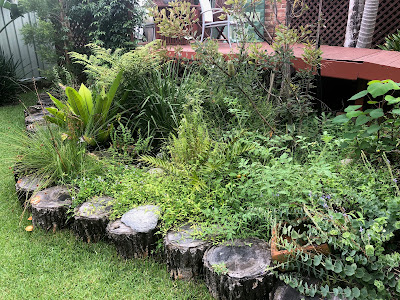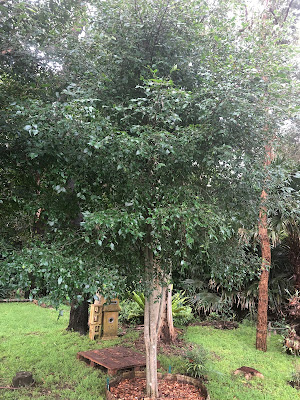A couple of weeks I cycled to the upper reaches of Tarrawanna to check out some creekside bush regeneration done by a couple of keen locals, Judy Mitchell and Neville Lockhart. But I was thoroughly distracted by their beautiful garden, a mix of local natives and edible plants from further afield. Here are just a few pictures showing what they've done with indigenous species.
 |
| Robust and tolerant of full sun and harsh conditions, Red Flowered Paperbark (Melaleuca hypericifolia) is ideal as a screening hedge in full sun situations. It can be pruned to keep it fairly neat and narrow, or left to do its own thing, in which case it will be quite broad, as befits one of its common names, Hillock Bush. It also has beautiful orange-red flowers in spring or summer. NB the Kangy Paws aren't local! Image by Emma Rooksby. |
 |
| The entrance to the house features a striking large Rough Tree Fern (Cyathea australis) which helps shade and shelter a Bird's Nest Fern (Asplenium australasicum). The low plant in the foreground is a Fan-flower, probably Fairy Fan-flower (Scaevola aemula), a tough and colourful little groundcover. Image by Emma Rooksby. |
 |
| A pond below the deck helps with cooling. It's full of a range of native plants including more Birds Nest Fern, Bleeding Heart (Homalanthus populifolius), Binung fern (Christella dentata), Prickly Rasp Fern (Doodia aspera) and many others. Frogs love this kind of habitat. Image by Emma Rooksby. |
 |
Garden borders are filled with a range of self-selecting local native species such as Pollia (Pollia crispata) top left, Kidney Weed (Dichondra repens), the ubiquitous Snake Vine (Stephania japonica var. discolour) and small local sedges (Cyperus sp.). NB couple of exotics in there too! Image by Emma Rooksby.
|
At the bottom of the garden is public land adjoining Towradgi Creek. This land, which runs behind private houses, is cared for in various ways by local residents. In this particular spot, lots of time and care have gone into removing troublesome weeds and supporting the local species to regenerate.
 |
| These beautiful small trees are Whalebone Trees (Streblus brunonianus), a tough tree that copes in some of the driest local rainforests. It's a key component of the endangered local Illawarra Subtropical Rainforest. Also a great small tree to attract birds, which love the fruit. Image by Emma Rooksby. |
 |
Beneath the Whalebone Trees is the start of an impressive native meadow of mixed grasses and other ground cover plants including Kidney Weed (Dichondra repens), Weeping Grass (Microlaena stipoides) and Austral Bugle (Ajuga australe) (not pictured). Image by Emma Rooksby.
 | | This area features some spectacular larger plants too, including this Bird's Nest Fern (Asplenium australasicum). Image by Emma Rooksby. |
|
 |
| Towradgi Creek at the bottom of the slope is a difficult area to manage, with many weeds along its length and a mix of land tenures. This section is looking good, with Sandpaper Figs (Ficus coronata) and other rainforest species developing a canopy and mixed ferns, groundcovers and tree seedlings growing underneath. The water is clear and flows well. Image by Emma Rooksby. |
 |
| Establishing native species include Bungalow Palm (Archontophoenix cunninghamiana), Sandpaper Fig (Ficus coronata) and Scentless Rosewood (Synod glandulosum). Image by Emma Rooksby. |
 |
| Native ferns growing along the creek bank include Binung (Christella dentata), Bird's Nest Ferns and Prickly Rasp Ferns (Doodia aspera). This shot shows the Binung, which is quite common along creeks in the region. Image by Emma Rooksby. |
 |
| A native beehive provides habitat for solitary bees. Image by Emma Rooksby. |
Illawarra is full of interesting gardens like this, each cared for in a unique way and contributing to protecting and restoring local biodiversity. They may be less showy than some gardens focused on exotics, but they play an important part in our local environment. And there's usually at least one or two flowers to see if you keep your eyes peeled! |
| Small but pretty, this is a small colony of Pastel Flowers (Pseuderanthemum variabile), just starting to flower near the creek. Image by Judy Mitchell. |















No comments
Post a Comment